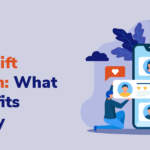5 Easy Ways Your Website Can Boost Your Fundraising Results

If you’re a professional at a nonprofit, you probably understand how stressful hitting your fundraising goal can be. You might also feel overshadowed by all the big guys who have the resources to conduct massive outreach campaigns. Luckily, there are affordable and effective tools you can leverage to spread awareness and get people excited about your fundraising efforts—namely, your website.
Web design is still a relatively new field that’s changing all the time, but the resources available to your nonprofit make it easier than ever to transform your site into a conversion machine. The best nonprofit websites out there incorporate smart fundraising strategies into their designs to attract the most attention and support for their initiatives. Without further ado, let’s dive into how you can reach the hearts—and the wallets—of your site visitors and convert them into loyal donors.
1. Use calls to action.
Make the donation process as simple as possible so donors can quickly and easily contribute to your cause. This means encouraging donations immediately after visitors click through to your page. Save the longer stories for your “About Us” tab or your blog and try using calls to action on your homepage instead.
A call to action (CTA) is a punchy and straightforward slogan used to prompt action. Some classic examples include “Donate Now!” or “Contact Us.” When crafting your CTAs, be sure to:
- Keep them short, so it only takes a glance to understand the point.
- Be specific as to what action you’d like visitors to take.
- Create a sense of urgency that encourages visitors to take action immediately.
- Make them stand out on the page with large text and eye-catching colors that align with your branding.
Also, CTAs are great for use in other contexts, like social media and email. Engaging CTA text and a solid visual design can direct traffic from your social profiles and email newsletters to your website.
2. Promote your fundraising events.
As the home base for your online presence, your website should be up-to-date on all things your organization. Therefore, you should always update your site with exciting developments, such as upcoming events and programs. You can do this in a variety of ways:
- Integrate an interactive event calendar. Many website builders will allow you to integrate an editable calendar feature into your events page. You can also configure your events to be downloadable to numerous calendar platforms, such as iCloud, Google Calendar, and Outlook. This tool makes the event planning process simple for both you and your guests!
- Include an online sign-up form. Ditch the antiquated RSVP envelopes for this environmentally- and user-friendly option. If your CMS has a survey tool, consider using that to keep track of your event attendees. If not, there are many third-party online platforms you can try, such as Google Forms, SurveyMonkey, and Eventbrite. This way, you can easily monitor your guest list. Plus, your guests will appreciate skipping the hassle of keeping track of paper invitations!
- Promote events in your existing materials and programs. A little self-promotion can go a long way! If you already have an audience in front of you, don’t be afraid to promote your upcoming events—whether you’re planning a dance-a-thon or participating in a webinar or panel. If you’re posting educational blogs, for example, use the space to mention what’s new for your nonprofit and encourage engagement with a link to the sign-up form.
- Incorporate virtual events into your website. If you’re hosting a virtual event, this one’s a no-brainer! One of the best ways to use your website is to create a link to the event through your website. For example, if you’re hosting a webinar, you can integrate Zoom into your website by using the Web Meeting SDK. This approach lets you meet visitors where they are, providing a direct pathway to your event and encouraging participation.
These are just a few tips to get you started. According to Cornershop Creative, nonprofit web builders provide even more opportunities for you to promote your fundraising campaigns. What’s most important is that you leverage every opportunity to spread the word!
3. Highlight matching gifts.
Your nonprofit can generate significant revenue from matching gifts. According to Double the Donation, corporate giving is a popular way for companies to boost employee engagement and enhance their reputation while powering lasting change in the community. Businesses tend to match their employees’ donations at a 1:1 ratio, though some match as high as 4:1.
However, many donors are still unaware of this opportunity. In fact, 78% of donors don’t know whether their employer offers a matching gift program. To avoid missing out on crucial funds for your mission, emphasize matching gifts on your website by:
- Creating a dedicated matching gifts page. Provide a one-stop resource for supporters interested in learning more about matching gifts. On this page, you can include a short overview of the process, along with how donors can check their eligibility to submit a matching gift request. This eliminates much of the guesswork and paves the way for more donors to tap into the generosity of their employers.
- Including a matching gift search tool on your donation page. When supporters navigate to your donation page to complete the giving process, make it easy for them to check their matching gift eligibility by embedding a search tool into the form. Then, all they need to do is fill out their basic information to learn all the details about their employers’ corporate giving programs.
- Designing matching gift CTAs. Another type of CTA you can include on your website is matching gift CTAs. On matching gift-related pages and blog posts, add eye-catching images and buttons that encourage donors to check their eligibility. Since 84% of people indicate that they’re more likely to donate if a match is offered, promoting matching gifts can also be an effective way to drive more supporters to donate to your cause.
At the same time, your website doesn’t need to do all of the heavy lifting for spreading awareness of matching gifts. Maximize your results by creating social media posts and email newsletter updates that encourage supporters to check their eligibility as well. You can also send reminders in follow-up communications such as thank-you emails.
4. Integrate shareable elements into your website.
Social media has so drastically changed the world that it can be difficult to imagine our society without it. The difference between outreach strategies with and without social media is probably even more apparent to fundraising professionals like yourself. The social media space is always evolving, and you can harness its latest trends through your website design.
Start by:
- Ensuring your social media profiles are up-to-date. If you’ve changed your branding or staff recently, refresh your social media profiles with the most accurate representation of your organization. Then, make sure your website has social sharing buttons that link to those profiles!
- Adding a shareable element to your online donation form. This is another great strategy for wedding both your social media presence and your nonprofit website. Once a donor fills out the form and their donation is processed, they’ll get the option to share a donation announcement on social media. Attached to the post will be a link back to the form, prompting their network to circle back to your website.
- Encouraging supporters to share your nonprofit’s success in the past year. Including your official annual report in a visible spot on your website, complete with your nonprofit’s wins from the past fiscal year, will show donors that you’re doing work worthy of donations. Try creating this as a downloadable PDF that supporters can share with their family and friends.
All of your website content positions you as a thought leader in your field. Allow your supporters to promote your advice for you by integrating shareable content into your website and providing easy access to the sharing buttons mentioned above. By doing so, their network will learn more about your organization and why they should donate and share the links with their followers. Before you know it, you’ll get prospects from entirely new communities paying you a visit!
5. Adopt donor recognition best practices.
Your nonprofit should work to go the extra mile in thanking your donors to increase repeat donations. You can scale up your donor appreciation while promoting your fundraising by using your website.
One of the most important traits of your donor recognition initiatives is their shareability. This is because sharing promotes social proof, the idea that people in your network are more likely to donate once they see that you’ve already donated. So, your donor recognition materials should be sharable to reach as many people as possible and prompt donations by reiterating that every gift counts. This way, your efforts to thank donors will be doubly effective—they’ll increase donor satisfaction while introducing new people to your fundraising initiatives.
There are countless ways to show your appreciation, but here are two popular methods:
- Use a virtual donor recognition wall. Chances are you’ve seen many donor appreciation plaques in building lobbies and on memorials. This is the same idea, but for a digital platform. You’ll dedicate a page on your website to show your givers how much they mean to you. Consider highlighting donation tiers, time spent supporting your organization, or board status, depending on what you know about your donors. Another idea for a digital donor recognition wall is highlighting “why I give” stories from some of your top donors. Once a donor has been added to the wall, ensure that there’s a way for them to spread the word with a social media button.
- Create special blog content. This is a great way to bolster your site’s content while applauding your supporters. You could implement a “Donor Spotlight” series on your blog where you highlight a specific donor and their contributions to the fundraising campaign. Or, you can have a supporter write a guest post for your blog about what your cause means to them. Whatever you choose, encourage your donor to share the content with their network to get more eyes on your fundraiser.
If you recognize donors while a fundraising campaign is still underway, encourage them to share their shoutout among their own networks to get other people interested. Then, new potential supporters may visit your social media profiles or your website to learn more and, hopefully, give to your cause.
Your nonprofit’s cause is worth sharing and supporting. Now that you have the tools to spread the word with your website, it’s time to get to work. Use a nonprofit website builder to make necessary updates and promote your fundraising efforts across the Internet.
Better yet, partner with a nonprofit web design company to hand the reins over to tech-savvy professionals. They’ll help you optimize your site for fundraising so you can focus more of your time on strengthening your relationships with donors instead of learning how to code! Good luck!


